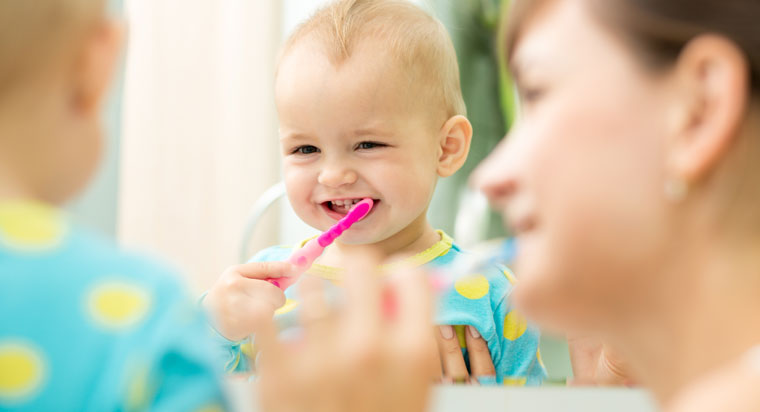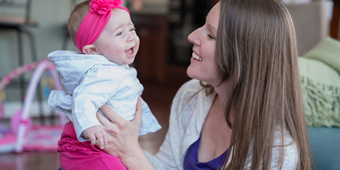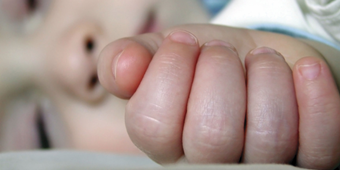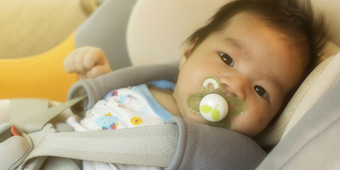Caring For Baby’s Pearly Whites

Find Your Perfect Match
Answer a few questions and we'll provide you with a list of primary care providers that best fit your needs.
While at this point, your baby’s mouth may be pink as could be, it won’t be long before tiny pearly whites start to show up. And, even now, it’s not too early to begin caring for your baby’s gums and teeth.
As your baby grows, here’s what dental care should look like:
Birth To 6 Months
Start cleaning your newborn’s gums a few days after you get home from the hospital. You can use wet cotton gauze or a clean, wet washcloth. Cradle your baby in one arm and use the index finger of your free hand to gently massage his gums.
Your baby’s first tooth generally pops up between four and eight months. When he is teething, his gums may be red and swollen, and he may have more saliva. You can give him a cold teething ring or a cold, wet washcloth to help with the pain. If he has a fever or diarrhea, don’t chalk up those symptoms to teething. Call your doctor instead.
If you give your baby a bottle, don’t let him have it outside of his mealtimes and, especially, don’t let him fall asleep with it. The sugars in the milk will quickly cause tooth decay.
As soon as your baby’s first teeth come in, start brushing with a baby-sized toothbrush. You can use water, a grain-size amount of fluoride toothpaste, or nonfluoride training toothpaste.
One more tip for caring for your young baby’s teeth: If he uses a pacifier and it falls on the ground, don’t “clean” it by popping it into your own mouth. This spreads cavity-causing bacteria from your mouth to your baby. (For the same reason, don’t share eating utensils.)
As soon as your baby’s first teeth come in, start brushing with a baby-sized toothbrush.
6 Months To 1 Year Old
If your baby’s first tooth didn’t show up in her first six months, you can expect the big event any day now. Use the cold washcloth or teething ring tip already mentioned to help ease the pain.
.jpg?sfvrsn=efc88124_4) Schedule your child’s first dental exam within six months of getting her first tooth (or some time before her first birthday). Make sure you’re familiar with her mouth, frequently lifting her lips and checking her teeth for white or brown marks — the first signs of cavities.
Schedule your child’s first dental exam within six months of getting her first tooth (or some time before her first birthday). Make sure you’re familiar with her mouth, frequently lifting her lips and checking her teeth for white or brown marks — the first signs of cavities.
Besides breastmilk or formula, your baby’s other source of hydration should be water (not juice). Find out if your drinking water is fluoridated. Fluoride prevents up to 25 percent of cavities. If your water is not fluoridated, talk to your physician and find out if your baby should receive fluoride in another form.
Age 1 Year to 18 Months
Wean your baby from using a bottle to drink. Most babies between 12 and 14 months can start using a cup. Keep checking his mouth for white or brown marks on the teeth. And, if he hasn’t had a dental checkup yet, now is the time to schedule that appointment. Keep brushing his teeth at least two times a day.
18 Months To 5 Years Old
When your baby is no longer a baby, keep helping her brush at least two times a day. As soon as she has two teeth next to each other, you can also start to floss daily. As she gets older, she can start to floss herself. By the age of 6 or 7, your child should be able to brush all by herself without your supervision. And then, once she reaches school age, you’ll get to look forward to the loss of all those cute baby teeth and the grand entrance of grown-up teeth.
One last tip: A childhood of tooth brushing may not be complete without learning Raffi’s classic “Brush Your Teeth” song. If you learn it early, it’s a great way to get through tooth brushing frustrations.
Find Your Perfect Match
Answer a few questions and we'll provide you with a list of primary care providers that best fit your needs.
Sources: American Dental Association; New York State Department of Health




